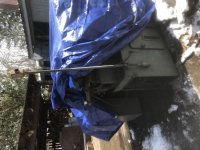Donn
Aluminum
- Joined
- Mar 4, 2009
- Location
- Northern New Jersey
I'm going back to look for the exciter tomorrow. Anyone got a pic of what it looks like?
Follow along with the video below to see how to install our site as a web app on your home screen.
Note: This feature may not be available in some browsers.
Other than all TF over the Monarch forum on {PM?
Yea. You got me there. Should have looked there first instead of google images.
I'm pretty sure I saw that at the shop.
... It's the big Ohmite rheostats that you need to have enough parts to attempt to put the original drive back in service.
... Meanwhile.. "dollars and cents-wise, it is WELL WORTH trying to find an OEM exciter!
Better yet, a complete MG with one still on it.




It looks to me as if the original DC Control Panel and motor/generator (sans exciter) are still part of the system. This makes no sense if the spindle motor is an AC motor. Can you post a photo of the data plate on the spindle motor:I spoke at length today with the previous owner about the history of the machine. He is 91 years old and purchased the machine in the early 1960s. The machine left the factory with the standard M/G setup and standard tailstock. It was then retrofitted with the turret tailstock and control cabinet, which eliminated the need for the exciter, which is 60 years gone. The wire box above the generator is part of the retrofit and leads out and up to a multi pin connector which the big control cabinet plugs into. Perhaps the tubes and circuits in that cabinet did the work of the exciter. In any case, I do intend to use the original DC motor and replace what is missing as time and funds allow. The speed pot and chain and sprocket linkage are also missing. ...
View attachment 344431 View attachment 344440


What do you plan to use to power the machine? Do you have 3-phase or are you planning to use something like a rotary phase converter?
Cal
Is this a "rotary phase converter" (RPC) or something else? A 5HP RPC is marginal for a 10EE, but some people are successfully using them. An RPC with a 7.5 HP idler motor is sufficient. It will run from a 30A, single phase 240 circuit.I have a 5 HP 3 PH converter at 220V
OK, that makes sense. The four GL-393-A tubes are thyratrons; the EL-1C is a full wave rectifier. That sounds about right for a circuit that can control the field windings of both the spindle motor and the generator. (Controlling the generator's field indirectly controls the spindle motor's armature.) I don't think that you'll find the Ohmite rheostats in the cabinet. Was there any electrical documentation in the cabinet? (This was obviously a professionally designed and built system.)The tubes plugged in to the four sockets with labels GL-393A and one EL1 C . The front of the big cabinet has the 10 switches. I'll take better pics when I get back to the shop where it's waiting to be scraped.
View attachment 344723 View attachment 344724
Notice
This website or its third-party tools process personal data (e.g. browsing data or IP addresses) and use cookies or other identifiers, which are necessary for its functioning and required to achieve the purposes illustrated in the cookie policy. To learn more, please refer to the cookie policy. In case of sale of your personal information, you may opt out by sending us an email via our Contact Us page. To find out more about the categories of personal information collected and the purposes for which such information will be used, please refer to our privacy policy. You accept the use of cookies or other identifiers by closing or dismissing this notice, by scrolling this page, by clicking a link or button or by continuing to browse otherwise.
